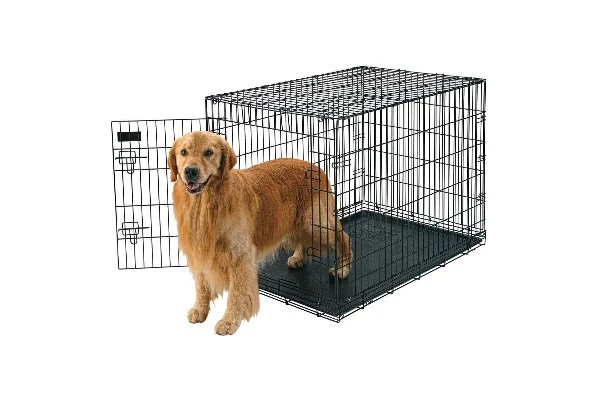Crates provide a haven for dogs, appealing to their desire to seek comfort in cozy spaces. But with so many options for dog crate sizes and styles, choosing the perfect one for your dog can feel overwhelming. So, what size crate for golden retriever? Here’s what to know.
Dogs naturally seek the safety of dens when they feel ill, injured, afraid, or need a secure place to rest, especially while raising young.
Providing a designated space for dogs to decompress and relax improves their quality of life. Crate training keeps pets safe when unsupervised and helps prevent bad habits like chewing. For house-training puppies, a well-fitting crate serves as an indispensable tool.
Quick Navigation
What Size Crate for Golden Retriever | Choosing the Right Dog Crate Size
Golden Retriever vs Labrador Retriever Comparison – What size crate for a Golden Retriever? Selecting the right crate size is crucial for your dog’s comfort and safety. Here are some parameters to help determine if a crate is the right size for your dog.

Standing Room:
Your dog should be able to stand up easily inside the crate, fit through the door effortlessly, and comfortably turn around. This means measuring your dog’s height from the floor to the top of their head while standing.
Ensure the crate’s height exceeds this measurement by at least a couple of inches to provide sufficient headroom. This is essential for the dog’s comfort and prevents them from feeling cramped, which can lead to anxiety and discomfort.
Head Clearance:
When your dog sits in the crate, there should be at least 2 inches of clearance above its head. This additional space allows your dog to sit comfortably without its head touching the top of the crate, which can be particularly important for taller breeds like Golden Retrievers.
Adequate headroom ensures your dog can sit naturally and observe its surroundings, which can help it feel more secure and less confined.
Stretching Space:
When your dog lies on its side, it should be able to fully extend its limbs. Measure your dog from the tip of its nose to the base of its tail to determine the minimum length of the crate.
This ensures that your dog can stretch out completely, which is crucial for its comfort, especially during longer periods spent in the crate. Dogs that cannot stretch out may develop sore muscles or become restless.
If any of these parameters are too tight for your pet, it’s best to go up the next size. Not having enough space in the crate can lead to negative feelings about the space and make crate training unpleasant for the pet.
However, a crate that is too large isn’t ideal either, especially for house training, since it can cause accidents in the crate.
Dogs may use the extra space as a bathroom area, which can hinder the house-training process. The key is to find a balance where the crate is large enough for comfort but small enough to discourage eliminating inside it.

How To Find a Crate for Your Dog’s Size?
It’s important to base the size of the crate on your dog’s measurements, not just their weight or breed.
- Weight and breed recommendations provide estimates, but each dog is an individual.
- Use a measuring tape to get the best understanding of your dog’s size. This approach ensures a more customized fit, as even dogs of the same breed can vary significantly in size and build.
- Consider that crate mats and dog beds will take up additional space when choosing a crate.
- When taking your pet’s measurements and purchasing a crate, make sure to account for the type of bedding you plan to use.
- A thick, plush bed may require more room, so you might need to size up slightly to comfortably accommodate both your dog and its bedding.
Ensuring that the crate is not too cramped with bedding allows your dog to move around freely and find its preferred sleeping position. Hope you know the answer to “What size crate for golden retriever?”
Dog Crate Sizing Chart
The following sizing chart can help you select the right crate size for your Golden Retriever or any other breed. This chart takes into consideration the typical dimensions of various dog breeds and can serve as a useful guide:
Crate Size for a Golden Retriever
For a Golden Retriever, which typically weighs between 55-75 pounds and stands around 22-24 inches tall at the shoulders, a crate size of 42″ x 28″ x 30″ is generally recommended. This size allows sufficient room for the dog to move, stand, turn around, and lie comfortably without being too spacious.
Golden Retrievers are active and robust dogs, and they need enough space to be comfortable, but not so much that they feel lost or are tempted to use a corner as a bathroom.
Golden Retrievers are known for their friendly and gentle temperament, making them popular family pets. They thrive on human interaction and need a safe space to retreat to when they need to rest or feel secure.
A properly sized crate can provide this sanctuary, helping to reduce stress and anxiety. Additionally, a crate can be particularly useful when traveling, providing your dog a familiar and secure environment. Whether you’re going on a road trip or a short visit to the vet, a crate can make the journey less stressful for your pet.

How To Pick a Puppy Crate?
Because young dogs grow so quickly, there are a few options when choosing the best crate for a puppy:
Crate with a Removable Divider:
You can purchase a crate for your puppy’s expected adult size and use a removable divider. Dividers can be moved back as the puppy grows, allowing the crate to grow with them.
This is a cost-effective solution, as it eliminates the need to purchase multiple crates as your puppy matures. It also ensures that your puppy always has a properly sized space, which is crucial for their comfort and training.
Multiple Crates:
Another option is to purchase multiple crates as your puppy grows. This is particularly useful when the adult size of the pup is difficult to estimate. For example, if you adopt a mixed-breed puppy or a breed known for significant size variation, having different-sized crates can more accurately accommodate their growth stages.
This approach allows you to tailor the crate size more precisely to your puppy’s current size, ensuring optimal comfort and training conditions at each stage of their development.
When purchasing a crate for a puppy, consider its potty training and teething needs. Puppies have smaller bladders and must relieve themselves more frequently than adult dogs. Therefore, an easy-to-clean crate is essential for managing accidents.
Crates made of durable materials that can withstand chewing are also ideal, as puppies explore their environment with their mouths and can be prone to chewing on anything within reach.
What Are Crates Made Of?
Crates made of coated steel wire are excellent options because they are durable, easy to clean, provide good ventilation, and let your dog see what is happening around them. This visibility can help reduce anxiety as puppies feel more connected to their surroundings inside the crate.
If your dog is more comfortable in an enclosed crate, you can always add a crate cover that can be removed as needed. This flexibility allows you to adjust the level of enclosure based on your dog’s comfort and the environment, such as creating a darker, more den-like space for nighttime or travel.
A well-chosen crate serves as a practical tool for training and safety and becomes a cherished personal space for your dog. It can be a place where they retreat after a long walk, a safe spot during a thunderstorm, or simply a cozy corner where they can enjoy a chew toy in peace. Check out this Golden Retriever Meal Plan to ensure your pup gets the best nutrition alongside a comfortable living space.
Investing time and effort into selecting the right crate will pay off in the form of a happier, healthier dog and a more harmonious household.
Conclusion
Choosing the right crate size for your Golden Retriever is essential for their comfort, safety, and well-being. By measuring your dog accurately and considering their growth, you can ensure that the crate provides a cozy, den-like environment that will help your pet feel secure and relaxed.
When done correctly, crate training can significantly enhance your dog’s quality of life and make managing their behavior and safety much easier for you as a pet owner. Proper crate training can lead to a happier, more well-adjusted pet who feels secure and comfortable in their space. Now you know, what size crate for golden retriever.





